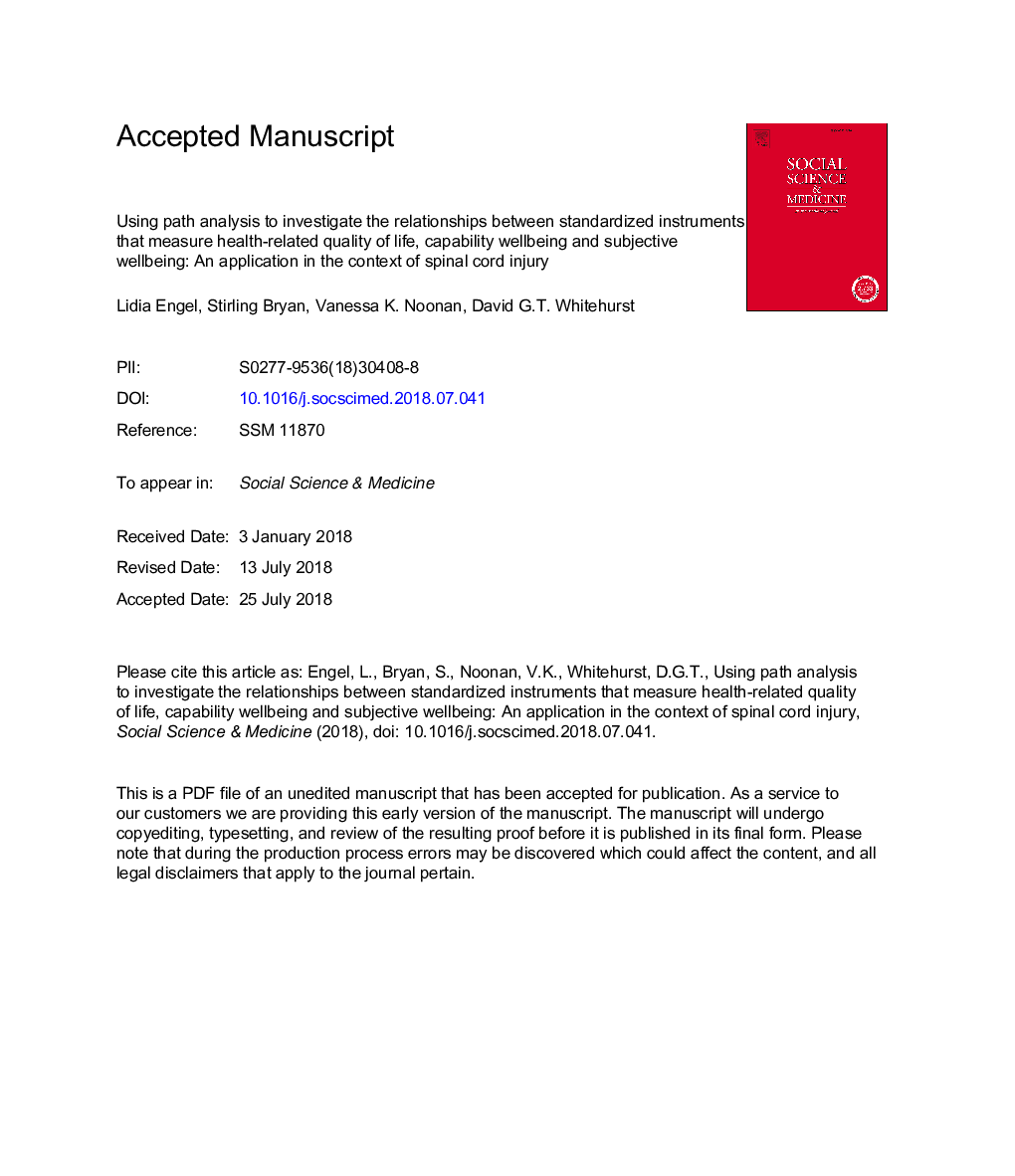| کد مقاله | کد نشریه | سال انتشار | مقاله انگلیسی | نسخه تمام متن |
|---|---|---|---|---|
| 7327239 | 1475956 | 2018 | 43 صفحه PDF | دانلود رایگان |
عنوان انگلیسی مقاله ISI
Using path analysis to investigate the relationships between standardized instruments that measure health-related quality of life, capability wellbeing and subjective wellbeing: An application in the context of spinal cord injury
ترجمه فارسی عنوان
با استفاده از تجزیه و تحلیل مسیر برای بررسی روابط بین ابزارهای استاندارد که کیفیت زندگی مرتبط با سلامت، رفاه توانایی و سلامت ذهنی را اندازه گیری می کند: کاربردی در زمینه آسیب نخاعی
دانلود مقاله + سفارش ترجمه
دانلود مقاله ISI انگلیسی
رایگان برای ایرانیان
کلمات کلیدی
کانادا، اندازه گیری نتیجه، ارزیابی اقتصادی، رفاه توانایی، کیفیت زندگی مرتبط با سلامت، رفاه ذهنی، آسیب نخاعی،
موضوعات مرتبط
علوم پزشکی و سلامت
پزشکی و دندانپزشکی
سیاست های بهداشت و سلامت عمومی
چکیده انگلیسی
While economic evaluations typically embrace health maximization as the maximization objective using quality-adjusted life years, there is increasing interest in the measurement of capability wellbeing and subjective wellbeing (SWB) for informing policy decisions. The objective of this study was to investigate the relationships between health-related quality of life (HRQoL), capability wellbeing and SWB. Data were used from 364 individuals living with spinal cord injury (SCI) who previously completed a web-based, cross-sectional survey (March-June 2013). Regression analyses were used to study the impacts of secondary health conditions on HRQoL, capability wellbeing and SWB; subsequently, a path analysis was used to assess direct and mediated pathways. HRQoL was measured using the EQ-5D-5L and the Assessment of Quality of Life 8-dimension (AQoL-8D) questionnaire; capability wellbeing was assessed using the ICEpop CAPability measure for Adults (ICECAP-A), and SWB was based on a single life satisfaction item (0-10 rating scale). Mean scores were 0.492, 0.573, 0.761 and 6.319 for EQ-5D-5L, AQoL-8D, ICECAP-A and SWB, respectively. Beta coefficients from the regression analyses indicated that secondary health conditions had the greatest negative impact on individuals' HRQoL (βAQoL-8Dâ¯=â¯â0.668, βEQ-5D-5Lâ¯=â¯â0.542), followed by SWB (βSWBâ¯=â¯â0.481) and capability wellbeing (βICECAP-Aâ¯=â¯â0.477). Capability wellbeing mediated the effect of secondary health conditions on HRQoL and SWB. The indirect effect of secondary health conditions on SWB through HRQoL was not statistically significant when using EQ-5D-5L; indirect effects were found when using AQoL-8D, one through HRQoL only and one through both capability wellbeing and HRQoL. This study highlights the different impacts of secondary health conditions on HRQoL, capability and SWB in the context of SCI. While the greatest impact was observed on individuals' HRQoL, our results provide further evidence that capability wellbeing (here, the ICECAP-A) adds complementary information about outcomes that could be used in economic evaluation.
ناشر
Database: Elsevier - ScienceDirect (ساینس دایرکت)
Journal: Social Science & Medicine - Volume 213, September 2018, Pages 154-164
Journal: Social Science & Medicine - Volume 213, September 2018, Pages 154-164
نویسندگان
Lidia Engel, Stirling Bryan, Vanessa K. Noonan, David G.T. Whitehurst,
